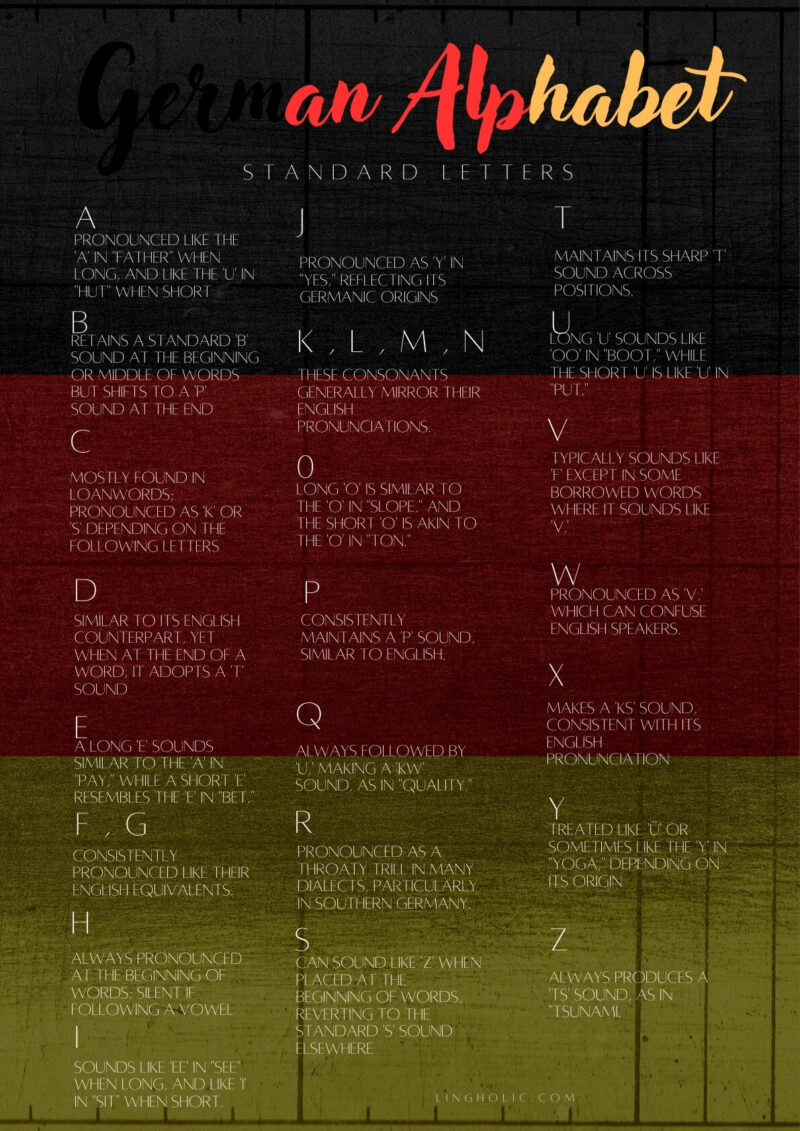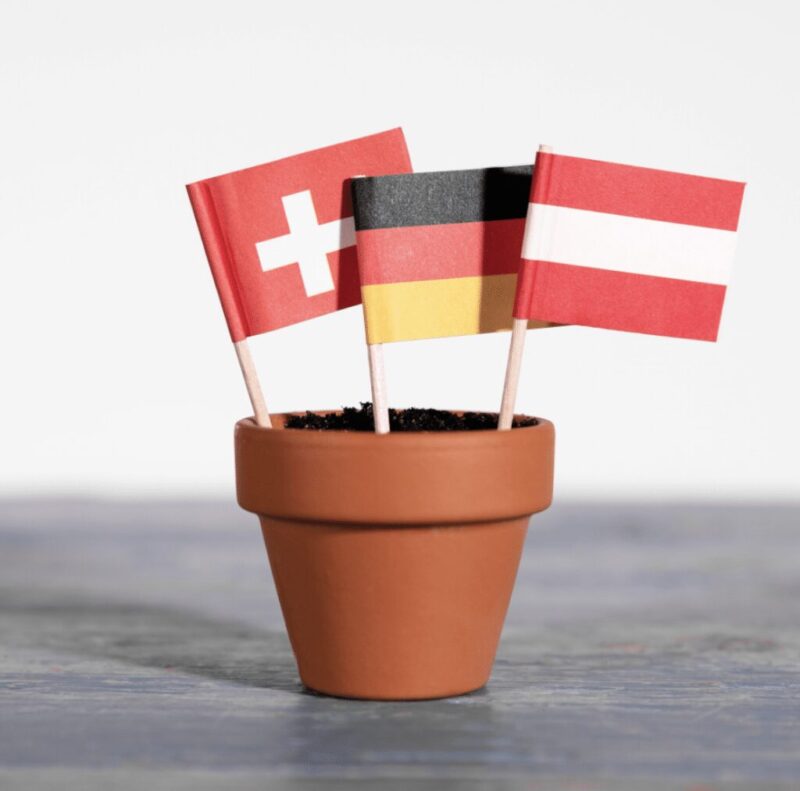Acquiring proficiency in a new language requires an emphasis on foundational skills. In German, correctly producing the sounds associated with each letter and combination is essential. The phonetic structures in this language can vary significantly from English and other languages.
This guide provides an overview of German phonetics to establish a basic understanding.
Standard Letters and Their Sounds

The German alphabet bears similarities to the English alphabet in terms of letters used but diverges notably in terms of pronunciation. Each of the 26 standard letters represents distinct phonemes, with some phonemes varying depending on the position within a word or proximity to other letters.
- A: Pronounced like the ‘a’ in “father” when long, and like the ‘u’ in “hut” when short.
- B: Retains a standard ‘b’ sound at the beginning or middle of words but shifts to a ‘p’ sound at the end.
- C: Mostly found in loanwords; pronounced as ‘k’ or ‘s’ depending on the following letters.
- D: Similar to its English counterpart, yet when at the end of a word, it adopts a ‘t’ sound.
- E: A long ‘e’ sounds similar to the ‘a’ in “pay,” while a short ‘e’ resembles the ‘e’ in “bet.”
- F and G: Consistently pronounced like their English equivalents.
- H: Always pronounced at the beginning of words; silent if following a vowel.
- I: Sounds like ‘ee’ in “see” when long, and like ‘i’ in “sit” when short.
- J: Pronounced as ‘y’ in “yes,” reflecting its Germanic origins.
- K, L, M, N: These consonants generally mirror their English pronunciations.
- O: Long ‘o’ is similar to the ‘o’ in “slope,” and the short ‘o’ is akin to the ‘o’ in “ton.”
- P: Consistently maintains a ‘p’ sound, similar to English.
- Q: Always followed by ‘u,’ making a ‘kw’ sound, as in “quality.”
- R: Pronounced as a throaty trill in many dialects, particularly in Southern Germany.
- S: Can sound like ‘z’ when placed at the beginning of words, reverting to the standard ‘s’ sound elsewhere.
- T: Maintains its sharp ‘t’ sound across positions.
- U: Long ‘u’ sounds like ‘oo’ in “boot,” while the short ‘u’ is like ‘u’ in “put.”
- V: Typically sounds like ‘f’ except in some borrowed words where it sounds like ‘v.’
- W: Pronounced as ‘v,’ which can confuse English speakers.
- X: Makes a ‘ks’ sound, consistent with its English pronunciation.
- Y: Treated like ‘ü’ or sometimes like the ‘y’ in “yoga,” depending on its origin.
- Z: Always produces a ‘ts’ sound, as in “tsunami.”
Special German Letters: Umlauts and Eszett

German features several special characters not found in the English alphabet: the umlauted vowels (ä, ö, ü) and the eszett (ß). These letters are crucial in German pronunciation and carry specific sounds that can change the meaning of words.
- Ä: This letter is pronounced like the ‘e’ in “met.” It can appear in both long and short forms, altering the pitch slightly depending on its use in words.
- Ö: Sounds similar to the ‘i’ in “bird” in British English. This vowel also has long and short forms, affecting how round and open the lips must be during pronunciation.
- Ü: Resembles the ‘u’ in “fur” for English speakers. The pronunciation involves rounding the lips tightly and pushing the sound through a narrow opening.
- ß: Known as “sharp S,” this character represents a double ‘s’ sound. It is used after long vowels and diphthongs and is particularly common in spelling the voiceless sibilant [s] sound in standard German. The eszett is replaced by “ss” in Switzerland and Liechtenstein.
Special Letter Combinations and Their Sounds

Certain letter combinations produce unique sounds, distinct from their individual letter sounds.
- CH: Has two main sounds; after ‘a’, ‘o’, ‘u’, and ‘au’, it produces a guttural sound, like in “Bach” or “nach”. After ‘e’, ‘i’, ‘ä’, ‘ö’, ‘ü’, and ‘eu’, it has a softer, hissing sound similar to ‘sh’ in “shine”.
- SCH: Always pronounced as ‘sh’ in English, like in “school” or “fish”.
- SP and ST: At the beginning of words or following prefixes, these are pronounced as ‘shp’ and ‘sht’, respectively. In other positions, they retain their standard English sounds.
- PF: Pronounced as a blend of ‘p’ and ‘f’, making it a distinct sound found in words like “Pferd” (horse).
- EI/AI: Both are pronounced as the ‘i’ in “mine”, providing a long ‘i’ sound.
- EU/ÄU: Both produce an ‘oy’ sound, as in “boy”.
- IE: Delivers a long ‘ee’ sound, similar to the ‘ee’ in “see”.
- CK: Represents a hard ‘k’ sound, ensuring the preceding vowel is short.
- TZ: Also ensures a short vowel sound before it, pronounced as ‘ts’, as in “sits”.
The Bottom Line
Regular practice is integral to developing proper pronunciation. So, take time for both production-focused exercises, such as reading passages aloud, as well as more receptive drills like listening to native speakers. Pay close attention to how individual phonemes and diphthongs are articulated in different contexts.
I’m John Guerrero, with a background in German (Major) and Greek (Minor), leveraging over nine years of translation experience. My academic and professional journey has earned me deep linguistic insights and cultural nuances. I’m very passionate about bridging languages, and always look to deliver content that inspires and informs.
Related Posts:
- Learning Spanish Alphabet Pronunciation (With Sound)
- Learn to Count in Spanish - Tips and Tricks on How…
- Learn to Count in German - Tips and Tricks
- 50 Basic German Words to Learn for Beginners
- 50 Everyday German Conversational Phrases You Must Learn
- Introduction to Beginners Spanish - Learn, Speak, Thrive!

